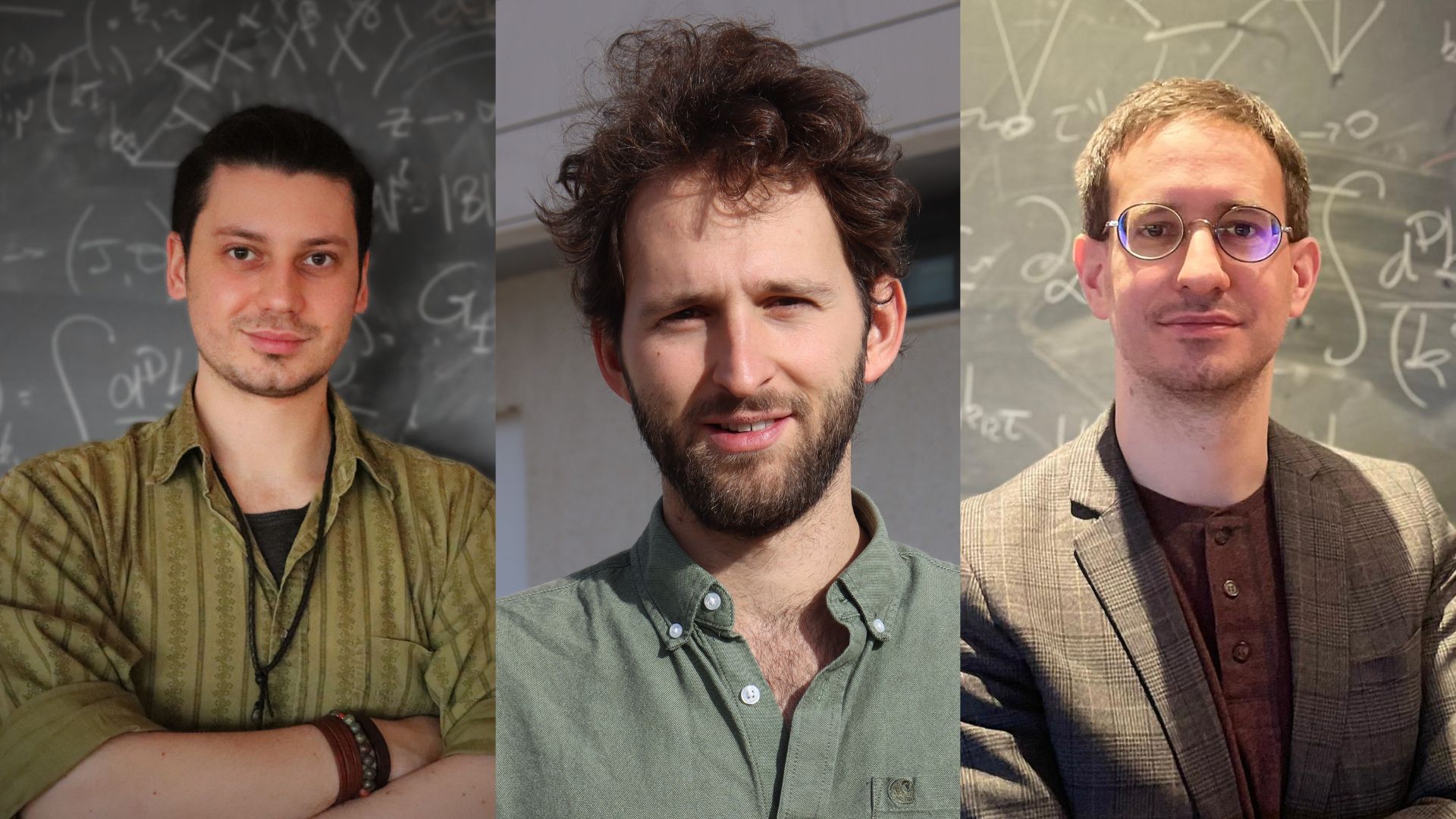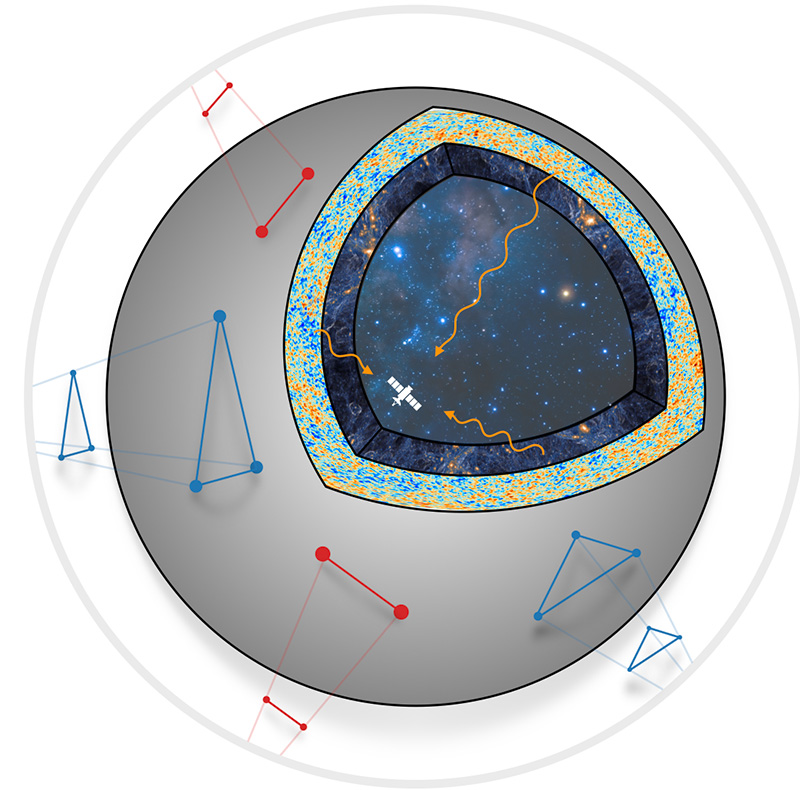DENIS WERTH, LUCAS PINOL AND SÉBASTIEN RENAUX-PETEL AWARDED THE BUCHALTER COSMOLOGY PRIZE 2023
Denis Werth, Lucas Pinol and Sébastien Renaux-Petel are awarded the second Buchalter Cosmology Prize 2023 for their work in cosmology and the development of a theoretical framework to study the physics of the primordial Universe. This is the first time that a French team is awarded this prize. The jury recognized that the innovative method they developed makes it possible to determine the observational consequences of any theory of the primordial Universe. It thus introduces a unique theoretical framework to interpret without bias the data from future cosmological surveys, that is to say the distribution of matter on large scales in the Universe, and to test theories of inflation.
 Figure 1: Denis Werth, Lucas Pinol, Sébastien Renaux-Petel.
Figure 1: Denis Werth, Lucas Pinol, Sébastien Renaux-Petel.
The team is made up of Denis Werth, doctoral student at the Institut d’astrophysique de Paris (IAP, CNRS and Sorbonne Université), Lucas Pinol, post-doctoral researcher at the Laboratoire de Physique de l'École Normale Supérieure (ENS, Université Paris Sciences & Lettres, CNRS, Sorbonne Université, Université Paris Cité), and former doctoral student at the IAP, and Sébastien Renaux-Petel, CNRS researcher, lecturer at the Ecole Polytechnique, and recipient in 2017 of a European Research Council grant to carry out the project “Theoretical and observational consequences of the Geometrical Destabilization of Inflation” (GEODESI), in the framework of which the awarded research was developed.
 Figure 2: Diagram illustrating different aspects of the cosmological flow. Cosmological correlators are represented by pairs and triplets of colored points (red or blue). The cosmological flow approach consists of following their temporal evolution, from a remote era of inflation represented by the outer light grey circle, until the end of inflation represented by the grey sphere (the extremely short duration of inflation is deliberately exaggerated in this image). The primordial density fluctuations which are described by these correlators then evolve in a known manner to structure the distribution of matter in the young and then current Universe (around 13.7 billion years after inflation). Thus, the different cosmological observations in the Universe inform us about these primordial correlators : the observations of the cosmological background radiation emitted 378,000 years after the end of inflation (this time interval is not represented in the diagram) which are represented by the outer layer of the sphere (in density map going from blue to red), then the observations of the distribution of matter at remote times represented by the thick layer of the sphere (extracted from a numerical simulation of large-scale structures), finally the observations of the distribution of more recent galaxies, located in the heart of the sphere. The next generation of cosmological surveys will probe with increased sensitivity the imprints left in the sky by primordial correlators , providing cosmologists with the opportunity to test advanced physical theories to describe the inflationary phase.
Figure 2: Diagram illustrating different aspects of the cosmological flow. Cosmological correlators are represented by pairs and triplets of colored points (red or blue). The cosmological flow approach consists of following their temporal evolution, from a remote era of inflation represented by the outer light grey circle, until the end of inflation represented by the grey sphere (the extremely short duration of inflation is deliberately exaggerated in this image). The primordial density fluctuations which are described by these correlators then evolve in a known manner to structure the distribution of matter in the young and then current Universe (around 13.7 billion years after inflation). Thus, the different cosmological observations in the Universe inform us about these primordial correlators : the observations of the cosmological background radiation emitted 378,000 years after the end of inflation (this time interval is not represented in the diagram) which are represented by the outer layer of the sphere (in density map going from blue to red), then the observations of the distribution of matter at remote times represented by the thick layer of the sphere (extracted from a numerical simulation of large-scale structures), finally the observations of the distribution of more recent galaxies, located in the heart of the sphere. The next generation of cosmological surveys will probe with increased sensitivity the imprints left in the sky by primordial correlators , providing cosmologists with the opportunity to test advanced physical theories to describe the inflationary phase.
Credits: D. Werth, L. Pinol, S. Renaux-Petel.
In their work, the authors demonstrated the efficiency of a new method for predicting the properties of primordial density fluctuations. These inhomogeneities were created during an extremely brief phase of accelerated expansion of the Universe, called cosmological inflation (its duration is not precisely known but its order of magnitude is 10-35 second), These inhomogeneities then collapsed (i.e. contracted) under the influence of gravity to form galaxies and the Universe as we know it. Our knowledge of these various inhomogeneities can only be statistical; it is contained in what we call “cosmological correlators”. These are statistical measurements characterizing the distribution of the field of sources that we study, whether primordial inhomogeneities or the distribution of galaxies on large scales. These measurements indicate, for example, what is on average (over the entire volume studied) the excess of sources at different distances from another source, compared to the expected number for a homogeneous distribution (called “two-point correlation function”). One can also examine the excess of sources at different distances of pairs of sources (“three-point correlation function”).
Thus, cosmological correlators describe the structure of inhomogeneities in the Universe, and make it possible to connect observations of the latter to theories of the primordial Universe. A priori, correlators can be calculated for any theory from first principles of physics, but in practice several difficulties have always prevented this, creating a bias between theories and theoretical predictions. The authors pioneered the development of the “cosmological flow”, a conceptual and technical framework that solves these problems and enables the systematic calculation of cosmological correlators, i.e. a fully automated process that can resolve all theories of inflation by a general method. Previously, this calculation was known to be complex and dependent on the model studied. The “cosmological flow” method tracks their temporal evolution from their origin as vacuum quantum fluctuations[1] until the end of inflation, providing an in-depth understanding of the physical processes at play during this phase of the early Universe.
This breakthrough allows the scientific community to explore new processes in high energy physics, that is to say at energies much higher than those achievable in terrestrial experiments (for example at the Large Hadron Collider). During the inflationary phase, extremely massive particles were produced and their subsequent decay into lighter particles left imprints in the distribution of primordial inhomogeneities. Thus, cosmological correlators hold the key to a completely unexplored physical regime, as they allow the detection of new particles and the characterization of their properties and their interactions. All this information would help physicists to establish a “standard model of cosmological inflation”. Similar to what computational algorithms have brought to particle physics, the cosmological flow method makes it possible to deduce the observational signatures of complex inflation theories, as the team showed in a companion article[2] of the award-winning article[3]. Numerous data are expected from large cosmological surveys, such as the Euclid space telescope or the Vera Rubin ground telescope. In this context, the cosmological flow makes it possible to generate theoretical data ensuring the unbiased interpretation of these observations. To progress more quickly in this direction, in addition to the publication of the formalism of the cosmological flow method, the authors of the study have made public their suite of computer programs.
The Buchalter Cosmology Prize is an annual award aimed at stimulating innovative theoretical, observational, or experimental work in cosmology that has the potential to produce a breakthrough advance in our understanding of the origin, structure and evolution of the Universe. It was created to support the development of new theories, observations, or methods, that can help enlighten the puzzle of cosmic expansion from first principles of physics. Announced at the annual meeting of the American Astronomical Society, the second prize is endowed with 5 000 US Dollars.
Note
[1] Temporary change in the energy level at a point in space, which leads to the spontaneous creation of particles.
References
[2] Companion article: D. Werth, L. Pinol, S. Renaux-Petel, 2024, “The Cosmological Flow: A Systematic Approach to Primordial Correlators”.
[3] Award-winning article: D. Werth, L. Pinol, S. Renaux-Petel, 2024, “Cosmological flow of primordial correlators”.
Link
![]() News of CNRS in the Earth & Universe theme, in the “Prize and distinction” category, January 17, 2024: “Denis Werth, Lucas Pinol and Sébastien Renaux-Petel win the Buchalter Cosmology Prize 2023” (in French)
News of CNRS in the Earth & Universe theme, in the “Prize and distinction” category, January 17, 2024: “Denis Werth, Lucas Pinol and Sébastien Renaux-Petel win the Buchalter Cosmology Prize 2023” (in French)
Writing and contacts
- Lucas Pinol
Laboratoire de Physique de l'École Normale Supérieure, Université Paris Sciences & Lettres, CNRS, Sorbonne Université, Université Paris Cité
lucas [dot] pinol [at] phys [dot] ens [dot] fr - Sébastien Renaux-Petel
Institut d’astrophysique de Paris, CNRS, Sorbonne Université
renaux [at] iap [dot] fr - Denis Werth
Institut d’astrophysique de Paris, CNRS, Sorbonne Université
denis [dot] werth [at] iap [dot] fr
Web writing: Valérie de Lapparent
Layout: Jean Mouette
February 2024
